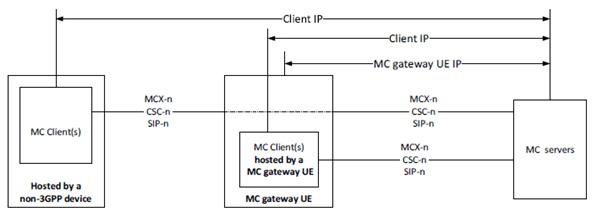Content for TS 23.280 Word version: 19.5.0
1…
5…
6
7…
8…
9…
10…
10.1.5…
10.2…
10.2.6…
10.3…
10.6…
10.7…
10.7.3.8…
10.8…
10.9…
10.9.3.9…
10.10…
10.10.3
10.11…
10.12…
10.13…
10.14…
10.15…
10.16…
10.17…
10.18…
10.19…
11…
11.5…
A…
B…
C…
E…
E MC gateway UE routing capabilities
E.1 General
E.2 MC client IP address association
E.3 IP address association using the MC gateway UE
$ Change history
E MC gateway UE routing capabilities |R18| p. 420
E.1 General p. 420
When the MC client resides on a non-3GPP device the use of the MC gateway UE requires the support of an IP network behind the MC gateway UE, that a range of IP addresses is reachable over a single MC gateway UE. That enables the forwarding of signalling information and media plane between an MC client on the non-3GPP device and the MC server by the MC gateway UE.
If the MC client resides on the MC gateway UE the MC gateway UE may support IP based and non-IP based connectivity behind it.
E.2 MC client IP address association p. 421
The use of a unique IP address by the MC clients shall be ensured for the period of association of the MC clients via the MC gateway UE with the IMS/SIP core and the MC server. Each MC gateway UE requires a unique IP address range for their MC client association which is known by the MC service environment and a correlation between the MC client's IP address and the MC gateway UE's IP address exists.

Framed routing in accordance with RFC 2865, RFC 3162, TS 23.501 shall be used to enable the support of an IP network behind the MC gateway UE, such that a range of IP addresses is reachable over a single 3GPP transport session. It allows the routing of packets to IP addresses that do not belong to the PDN/PDU session of the MC gateway UE.
E.3 IP address association using the MC gateway UE p. 421
If the MC client relies on IP address provided by the MC gateway UE, the MC gateway UE shall store the correlation between the non-3GPP device and the IP address (MC gateway UE IP and the local IP) used by the MC client . The procedures initiated by the MC client, i.e., SIP registration, user authentication and service authorisation use the MC gateway UE's IP address.
The MC gateway UE assigns the local IPs from address pool which it maintains to the individual MC clients. Managing the local IP addresses, re-using the local IP address, and how the traffic is routed between the MC clients and the network is left for implementation.
